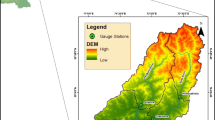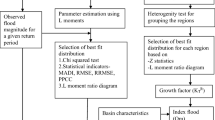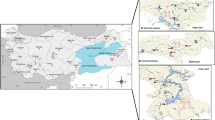Abstract
In Mexico, poverty has forced people to live almost on the water of rivers. This situation along with the occurrence of floods is a serious problem for the local governments. In order to protect their lives and goods, it is very important to account with a mathematical tool that may reduce the uncertainties in computing the design events for different return periods.
In this paper, the Logistic model for bivariate extreme value distribution with Weibull-2 and Mixed Weibull marginals is proposed for the case of flood frequency analysis. A procedure to estimate their parameters based on the maximum likelihood method is developed. A region in Northwestern Mexico with 16 gauging stations has been selected to apply the model and regional at-site quantiles were estimated. A significant improvement occurs, measured through the use of a goodness-of-fit test, when parameters are estimated using the bivariate distribution instead of its univariate counterpart. Results suggest that it is very important to consider the Mixed Weibull distribution and its bivariate option when analyzing floods generated by a␣mixture of two populations.
Similar content being viewed by others
References
Alila Y, Mtiraoui A (2002) Implications of heterogeneous flood-frequency distributions on traditional stream-discharge prediction techniques. Hydrol Process 16:1065–1084
Cavazos T, Hastenrath S (1990) Convection and rainfall over Mexico and their modulation by the Southern Oscillation. Int J Climatol 10:377–386
Cunnane C (1988) Methods and merits of regional flood frequency analysis. J Hydrol 100:269–290
De Michele C, Salvadori G, Canossi M, Petaccia A, Rosso R (2005) Bivariate statistical approach to check adequacy of dam spilway. J Hydrol Eng 10(1):50–57
Delgadillo J, Rodríguez D, Aguilar T (1999) Los aspectos económicos y sociales de El Niño. In: Los␣Impactos de El Niño en México. V. Magaña (ed) Dirección General de Protección Civil, Secretaria de Gobernación. México, 238 p (in Spanish)
Escalante C (1998a) Multivariate estimation of extreme flood hydrographs. Hydrol Sci Technol 14:19–27
Escalante C (1998b) Multivariate extreme value distribution with mixed gumbel marginals. J Am Water Res Assoc 3(2):321–333
Escalante C, Domínguez J (1997) Parameter estimation for bivariate extreme value distribution by maximum entropy. Hydrol Sci Technol J 13:1–10
Escalante C, Raynal JA (1994) A trivariate extreme value distribution applied to flood frequency analysis. J Natl Inst Stand Technol 99(4):369–375
Escalante C, Raynal JA (1998) Multivariate estimation of floods. The trivariate gumbel distribution. J Stat Comput Simulation 61(4):313–340
Gumbel EJ (1959) Multivariate distributions with given margins. Revista da faculdade de Ciencias. Serie A 2(2):178–218
Gumbel EJ (1960a) Multivariate extremal distributions. Bull Internat Statist Inst 39(2):471–475
Gumbel EJ (1960b) Distributions des valeurs extremes en plusiers dimensions. Publ Inst Stat Univ Paris 9:171–173
Kite GW (1988) Frequency and risk analyses in hydrology. Water Resources Publication
Kuester JL, Mize JH (1973) Optimization techniques with FORTRAN, McGraw-Hill
Magaña V, Ambrizzi T (2005) Dynamics of subtropical vertical motions over the Americas during El␣Niño boreal winters. Atmósfera 18(4):211–233
Magaña V, Vázquez J, Pérez J, Pérez JB (2003) Impact of El Niño on precipitation in México. Geofísica Internacional 42(3):313–330
Mood A, Graybill F, Boes D (1974) Introduction to the theory of statistics. McGraw-Hill
NOAA (1994) Report to the Nation. El Niño and Climate Prediction, 24 p
Raynal JA (1985) Bivariate extreme value distributions applied to flood frequency analysis Ph. D. dissertation, Civil Engineering Department, Colorado State University
Raynal JA, Salas JD (1987) Multivariate extreme value distributions in hydrological analyses. Water for the future: hydrology in perspective. Proc Rome Symp 164:111–119
Tiago de Oliveira J (1982) Bivariate extremes: models and statistical decision. Tech Report no 14. Center for stochastic processes, University of North Carolina, USA
Yue S (1999) Applying the bivariate normal distribution to flood frequency analysis. Water Int 24(3):248–252
Yue S (2000) The bivariate lognormal distribution to model a multivariate flood episode. Hydrol Process 14:2575–2588
Yue S (2001) A bivariate gamma distribution for use in multivariate flood frequency analysis. Hydrol Process 15:1033–1045
Yue S, Rasmussen P (2002) Bivariate frequency analysis: discussion of some useful concepts in hydrological application. Hydrol Process 16:2881–2898
Author information
Authors and Affiliations
Corresponding author
Appendices
Appendix A: Weibull-2 and Mixed Weibull distributions
The cumulative Weibull distribution function with two parameters is
where α and β are the scale and shape parameters.
The probability density function is given by
Parameters can be estimated by the direct maximization of equation (6)
where L is called the likelihood function, ln is the natural logarithm, α, β are the parameters to be estimated, and n is the length of record.
In flood frequency analysis, whenever the return period T is large compared with the length n of the available series, the error in the T-year flood estimate is greatly affected by the flood distribution model adopted. Difficulties are met in selecting a theoretical flood distribution mainly from the fact that in many sites some of the annual flood series exhibit one or more values ranking much higher than the bulk of the remaining data. Extreme events that are shown to be very unlikely to occur in a sample are called outliers.
The use of a mixture of probability distributions functions for modeling samples of data coming from two populations have been proposed long time ago (Mood et al. 1974):
where p is the proportion of x in the mixture and F(x) is said to be a mixture of distributions.
If two component are Weibull distributions with two parameters, equation (4) yields to the five-parameter mixture model of annual floods:
where α1 , β1 and α2, β2 are the scale and shape parameters for the first and second population, respectively, and p is the association parameter (0 < p < 1).
The corresponding probability density function is
Parameters can be estimated by the direct maximization of equation (10)
Appendix B: maximum likelihood procedure
The general form of the bivariate likelihood function is Raynal (1985):
where n 1 is the length of record before the common period, n 3 is the length of record after the common period, n 2 is the length of record in the common period, r is the variable with length n 1, x,y are the variables with length n 2, s is the variable with length n 3 and I i is a indicator number such that I i = 1 if n i > 0 or I i = 0 if n i = 0.
And its log-likelihood function is
Due the complexity of the mathematical expressions in equation (12) and the partial derivatives with respect to the parameters, the constrained multivariable Rosenbrock method (Kuester and Mize 1973) was applied to obtain the estimators of the parameters by the direct maximization of equation (12).
In any of the multivariable constrained non-linear optimization techniques, global optimality is never assured. Therefore, care must be taken in order to avoid a local optimum. It is suggested to start always with the parameters computed through the univariate maximum likelihood approach by fitting the univariate distribution to the data of the gauging stations to be analyzed. So, initial parameters of marginal distributions are obtained by using the same optimization algorithm, maximizing equation (6) or (10), depending on selected model.
Rights and permissions
About this article
Cite this article
Escalante-Sandoval, C. Application of bivariate extreme value distribution to flood frequency analysis: a case study of Northwestern Mexico. Nat Hazards 42, 37–46 (2007). https://doi.org/10.1007/s11069-006-9044-7
Received:
Accepted:
Published:
Issue Date:
DOI: https://doi.org/10.1007/s11069-006-9044-7




